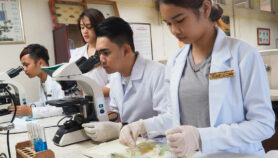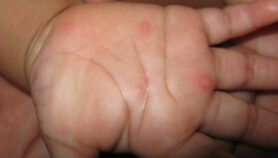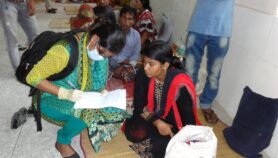By: Naimul Haq
Send to a friend
The details you provide on this page will not be used to send unsolicited email, and will not be sold to a 3rd party. See privacy policy.
[DHAKA] Geophagy or consumption of soil by children may be an important cause of stunting, says a new study conducted in rural Bangladesh. The tendency among children to eat soil and other non-food matter is also called pica.
According to the study by scientists at the International Centre for Diarrhoeal Disease, Bangladesh, (icddr,b), conducted in collaboration with the Johns Hopkins University, Maryland, geophagy is frequent among young children and leads to enteric infections.
The nine-month study published online in April in the American Journal of Tropical Medicine and Hygiene shows that enteropathy, described as inflammation of the intestines, is thought to arise from unsanitary environmental conditions leading to repeated exposure to enteric (intestinal) pathogens.
“We conducted the study to assess the relationship between geophagy and environmental enteropathy (EE) and stunting,” Christine Marie George, assistant professor at the Johns Hopkins Bloomberg School of Public Health and lead author of the study, tells SciDev.Net. “In our prospective group study of 216 children, aged 6—30 months, we conducted five-hour structured observations and obtained caregiver reports to assess geophagy events, and collected soil from the child’s outdoor play area.”
The study involved stool analyses for fecal markers of intestinal inflammation and observation of the children. Geophagy events were observed among 28 per cent of the children by caregivers while 18 per cent of the children were put under structured observation. Soil samples taken from play environments also showed the presence of pathogens such as Escherichia coli, strains of which are associated with food poisoning.
“Nearly all households had E. coli while 14 per cent had pathogenic E. coli,” George says. “Children with reported geophagy had significantly higher EE disease activity and a two times higher risk of stunting.”
The failure of nutritional interventions and oral vaccines in the developing world may be attributed to EE, as the intestinal functions of absorption and those related to immunology are significantly disturbed by repeated infections, says Mohammad Shahidullah, president of the Bangladesh Paediatric Association and senior professor of neonatology at the Bangabandhu Sheikh Mujib Medical University.
“Intestinal inflammation caused by EE from eating soil and non-food material is common among children,” Shahidullah tells SciDev.Net. ”This study very correctly points out that geophagy, or pica, is a risk factor for EE and stunting.”
Shahidullah, however, opines that a nine-month study may not be enough to full correlate geophagy and stunting. “A longer term study of not less than five years is needed,” he says.
>Link to full paper in American Journal of Tropical Medicine and Hygiene
This article has been produced by SciDev.Net's South Asia desk.














